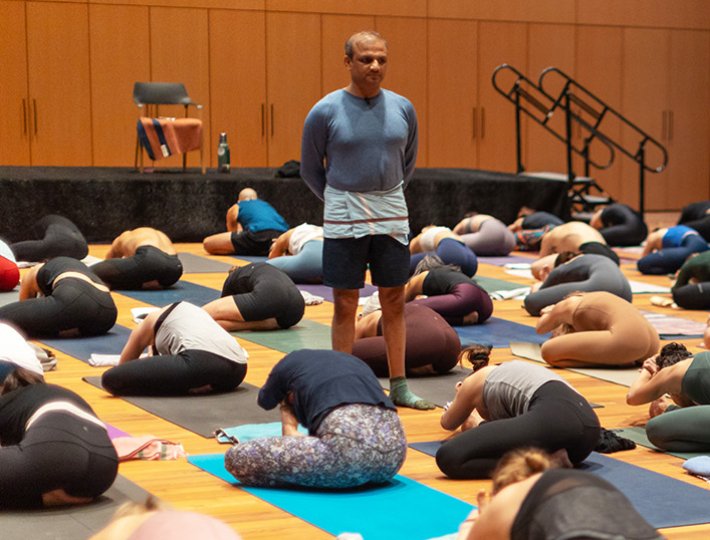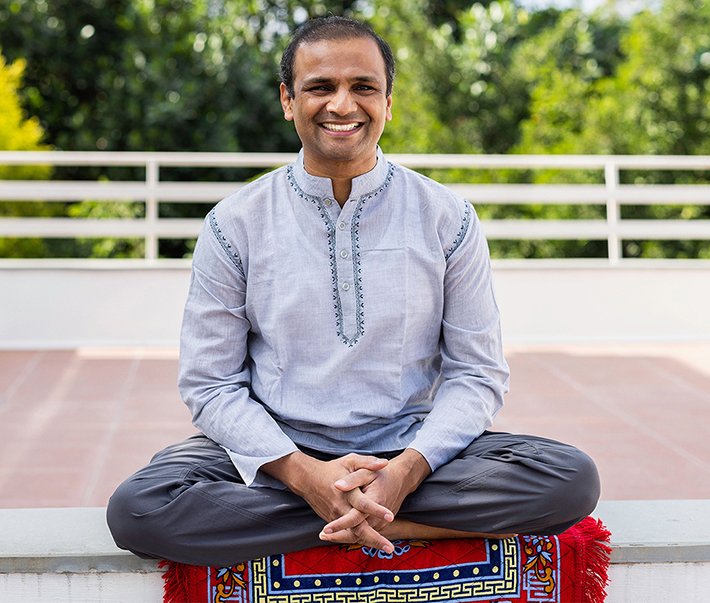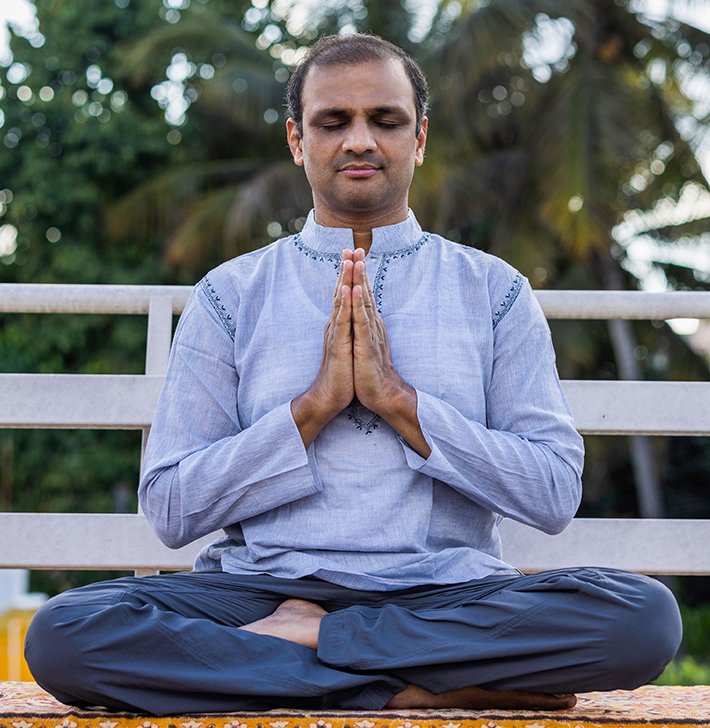The Sanskrit word “mantra,” from the roots “manas” (the linear thinking mind) and “tra” (to cross over), has found common use in Western vernacular. Though today we tend to equate mantras with spiritual aphorisms or repeated affirmations, mantras are traditionally defined as “sonic formulae that take us beyond, or through, the discursive faculties of the mind and connect our awareness directly and immediately to deep states of energy and consciousness,” writes Russill Paul in his book The Yoga of Sound: Tapping the Hidden Power of Music and Chant. In essence, many ancient mantras serve as vehicles for the mind to cross over the material world and into enlightenment.
Though this notion may seem lofty or far-fetched to the beginner yogi, the basic principle of mantra recitation is this: to use sound to cut through mental clutter, facilitate meditation practice, and create a deeper state of awareness. “A mantra provides a way to go beyond negative thoughts,” says Sharon Gannon, a yoga teacher and co-founder of the Jivamukti method. “Why should we attempt to go beyond negative thoughts? All of our words spoken, or said silently in our minds, create the reality we live in.” Mantras, then, not only have the power to evoke holiness or positivity, but indeed they can transform the reality of our perception.
Many of the sacred mantras chanted in yoga studios today are thousands of years old, dating back to Vedic times, and were created by sages and practitioners of early Hinduism and Buddhism. Sanskrit mantras are said to be particularly sacred because of the sounds and syllables that make up this ancient language. According to John Campbell, an Ashtanga yoga teacher and professor of religious studies at The University of Virginia, “[Mantras] cross over between the embodied energy of the physical self, and the disembodied energy of sound. When we work in yoga we’re navigating between body and mind; sound is this peculiar hybrid of the two that is intangible and yet vibratory.” For Campbell, sound is the basis of communication, and therefore can specifically call upon and engage the mind. “Like focus on the breath itself, focus on mantra has a unique ability to draw the mind into really tight focus,” he says.
There are 84 meridians on the roof of the tongue that are stimulated through Sanskrit mantra, and scientific evidence shows that mantras can facilitate the release of secretions that strengthen our immune and neurological systems. “Yogic mantras stimulate the secretions of the pituitary gland, which is located only millimeters from the palate…certain permutations send signals to the command centers of the brain—the hypothalamus, and the pituitary, primarily, and also to the pineal gland, [which] orchestrate a healing response and send out packets of information in the form of neurotransmitters and chemicals, in the brain and throughout the body,” writes Dharma Sing Khalsa, M.D., an expert in Kundalini yoga and researcher of Alzheimer’s disease.
Though some common mantras call upon Hindu deities, their main purpose is to cultivate awareness, intention, and elevated connection. “Mantras become the interface for mankind interacting with his spiritual world,” says Campbell. Though these mantras link to a specific religious tradition, the power of sound is paramount. “Virtually all spiritual traditions see sound as a key component of practice and connection to the divine or sacred,” he says. “The most important mantra of all, Om, is completely non-denominational and non-religious in the sense that it’s basic symbolism is creation itself.” Creation, and the evocation of its properties, are not owned by any religious tradition, notes Campbell.
The following phrases are a few examples of common mantras you may encounter in yoga class or meditation. Read on to dive into their meanings, their history, and their unique potency.
Related: 9 Empowering Mantras to Shift Your Mindset
Om Namah Shivaya
This salutation to Shiva, lord of destruction and transformation, and one of the primary gods of the Hindu Trinity, is perhaps the most common mantra in the Hindu and yogic traditions. “Om Namah Shivaya” is often referred to as “the five-syllable-mantra”—evoking the five elements of existence: earth, water, fire, air, and space. It is a Vedic mantra said to be both purifying and a healing. This mantra is particularly potent given Shiva’s connection to death and destruction. A key element of yogic philosophy is coming to terms with our own mortality and the impermanence of existence. Om Namah Shivaya, then, is not only elevating in the sense that it brings the chanter closer to the divine, but also in its courageous affirmation: I take solace even in the unknowable and unimaginable path of destruction.
Om Mani Padme Hum
This powerful mantra, which has deep roots in India and in Tibet, is one of the most commonly chanted mantras in the world. Every Tibetan child is taught Om Mani Padme Hum by their parents, and many Tibetan Buddhists chant the mantra as part of their ritual practice, thousands of times per day. Its meaning, as translated by the Dalai Lama, is: “The jewel is in the lotus, or praise to the jewel in the lotus.” The lotus, in the yogic tradition, symbolizes the profound ability of transformation: to emerge out of mud and blossom into a thousand-petaled flower. According to Alison Cramer, a yoga teacher and Ayurvedic practitioner in New York City, the lotus in this mantra is a symbol of the spiritual path. “By invoking this mantra, we are trusting that ‘jewels’ or wisdom, can be found by doing the work to come out of the mud, the darkness, the ignorance, and into beauty and grace,” says Cramer. In essence, the mantra is about compassion and universality, which as Cramer points out, is evoked in the very chanting of it: “When I chant it or teach it in class, I think about how as we are chanting it, millions of people all over the world are chanting it at the same time. And, for that matter, it links us to the lineage of those who have chanted it in the past and those who will be chanting it in the future. It is truly a gift to feel the connection of other souls doing the work just as we are—doing our best to rise, to ascend, to move into a life of freedom and joy.”
Lokah Samastah Sukinoh Bhavantu
This Hindu and Buddhist chant, which arises out of the Vedas, has been translated most commonly as, “May all beings everywhere be happy and free, and may the thoughts, words, and actions of my own life contribute in some way to that happiness and to that freedom for all.” In many ways, this mantra is the be-all and end-all for yogic purpose, as well as a clear embodiment of what the 14th Dalai Lama likes to call the spiritual practice of “enlightened self-interest.” We chant for our own personal transformation, not because we personally desire enlightenment, but rather so that we may contribute to the global transformation that will alleviate suffering and herald equality. “By working for the well-being for others,” says Campbell, “we benefit ourselves, and through our own fulfillment we become capable of sharing or bringing well being to others.”
“It is truly a gift to feel the connection of other souls doing the work just as we are—doing our best to rise, to ascend, to move into a life of freedom and joy.”
Om Asato Maa Sad-Gamaya
Tamaso Maa Jyotir-Gamaya
Mrtyor-Maa Amrtam Gamaya
Om Shaantih Shaantih Shaantih
Lead me from the unreal to the real
Lead from the darkness to the light
Lead me from death to immortality
Let there be peace, peace, peace
At the most basic level this mantra, taken from the Upanishads (800-300 BCE), evokes the experience of a yogi’s transformation from limited awareness to universal understanding. Swami Krishnananda, a renowned philosophical scholar and writer, offers another translation: “Let us rise above this turmoil of transiency of life, and move to the real which is indicated faintly in our own personal lives and in the manifestations that are in front of us.”
“This mantra speaks to the basic unadorned project of yoga, which is the transformation of the individual and their environment,” says Campbell. The desire to be led from the unreal to the real refers to the unreal or real perception of the self, says Campbell. In this world of false perception, he continues, “we are plagued either by self-aggrandizement or false humility, so coming into a realistic view of the Self, shifts us from the inability to powerfully fulfill ourselves and those around us. We are fixated with materialism; we are incapable of accessing our strengths because of our perceived misfortunes, instead of seeing ourselves as beings of potential.” The last verse on being led from death to immortality is the direction that all spiritual practice points towards, says Campbell. The three layers of this transformation—the self, the communal, and the transcendent—articulate the ever-expanding possibility of yoga and lead us to fully embody the light of self-awareness and then spread illumination to our communities and beyond.
Related: Why Can’t I Do Yoga Alone?
So Hum
Dating back to the Isha Upanishads in the first millennium BCE, this mantra is considered by Hindu and Buddhist traditions to be both a breath mantra and a philosophical aphorism meaning, “I am that.” The sound “so hum” can be easily paired with inhalation and exhalation, and when chanted to oneself, consciousness is said to expand from constriction to freedom. The so-hum utterance is said to be a unifier of masculine (hum) and feminine (so), while also vibrating on the same level as the silent and primordial AUM (Om). Affirming “I am that” is according to John Campbell, the antecedent to otherness. “Creation is unfolding in the world and we are like the unfolding world. We are not a single static unity, but rather, we are always changing, and we are constantly learning how to direct the acknowledgment of divinity inward,” says Campbell.
Guru Brahma Guru Vishnu Guru Devo Maheshwara
Guru Sakshat Parabrahma Tasmai Shree Guruvey Namaha
The Guru is Brahma (The creator), Lord Vishnu (The preserver), and Lord Shiva (the destroyer)
To that very Guru I bow, for He is the Supreme Being, right before my eyes.
In the yogic tradition, much emphasis is placed on the importance of the Guru—the one whose namesake and whose purpose is to help us see clearly and repel ignorance. In this mantra, we see the powerful connection between divinity and teachings, and the manifold pathways for truth. The Hindu Trinity composed of Bramha, Vishnu, and Shiva represent the three main elements of the self, and the three stages of life. By calling upon these gurus and gods we inevitably also call upon the teachings imbedded in our own existence. Many students of yoga see this mantra as one of the most self-empowering, in that it seeks to see the Guru as the one that lives within, or the one that is nearby. Too, this mantra invokes the power of a spiritual teacher, who is of “indispensible value in our transcendence of limited ego and of bound suffering,” says Campbell. “The true guru is the eternal guru. The value and power of an external leader, is that it guides us towards recognizing our own innate consciousness and perfection. It’s not about the abdication of power, and yet there is potential for awakening within oneself.” This mantra then, is in gratitude for all elements of existence and leaders we come across who help us orient ourselves toward our own awakening.












Comments (1)